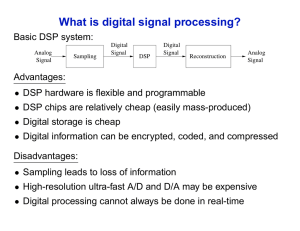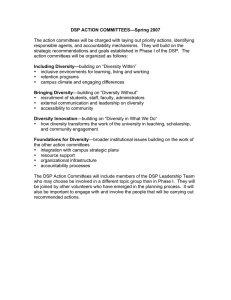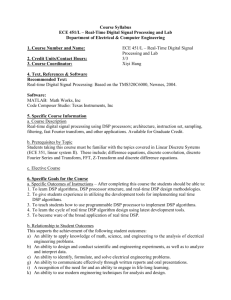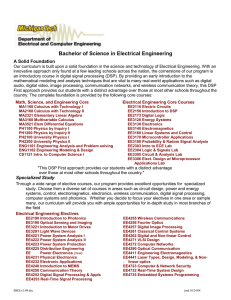DSP INSTEAD OF CIRCUITS? — TRANSITION TO HULMAN ABSTRACT
advertisement
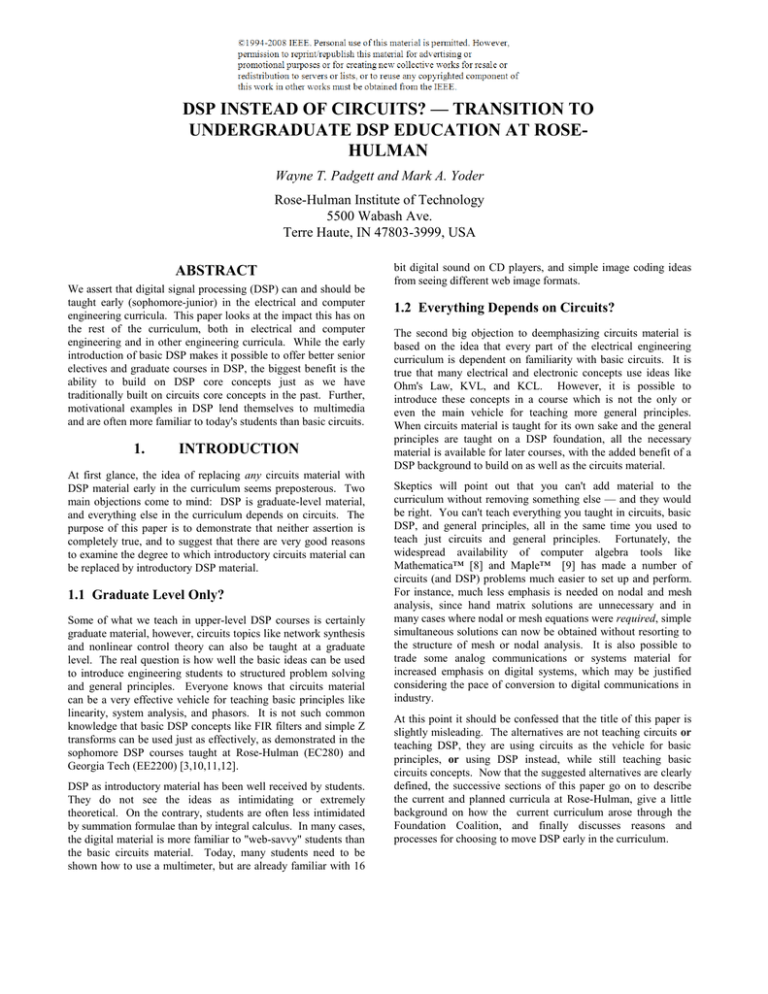
DSP INSTEAD OF CIRCUITS? — TRANSITION TO UNDERGRADUATE DSP EDUCATION AT ROSEHULMAN Wayne T. Padgett and Mark A. Yoder Rose-Hulman Institute of Technology 5500 Wabash Ave. Terre Haute, IN 47803-3999, USA ABSTRACT We assert that digital signal processing (DSP) can and should be taught early (sophomore-junior) in the electrical and computer engineering curricula. This paper looks at the impact this has on the rest of the curriculum, both in electrical and computer engineering and in other engineering curricula. While the early introduction of basic DSP makes it possible to offer better senior electives and graduate courses in DSP, the biggest benefit is the ability to build on DSP core concepts just as we have traditionally built on circuits core concepts in the past. Further, motivational examples in DSP lend themselves to multimedia and are often more familiar to today's students than basic circuits. 1. INTRODUCTION At first glance, the idea of replacing any circuits material with DSP material early in the curriculum seems preposterous. Two main objections come to mind: DSP is graduate-level material, and everything else in the curriculum depends on circuits. The purpose of this paper is to demonstrate that neither assertion is completely true, and to suggest that there are very good reasons to examine the degree to which introductory circuits material can be replaced by introductory DSP material. 1.1 Graduate Level Only? Some of what we teach in upper-level DSP courses is certainly graduate material, however, circuits topics like network synthesis and nonlinear control theory can also be taught at a graduate level. The real question is how well the basic ideas can be used to introduce engineering students to structured problem solving and general principles. Everyone knows that circuits material can be a very effective vehicle for teaching basic principles like linearity, system analysis, and phasors. It is not such common knowledge that basic DSP concepts like FIR filters and simple Z transforms can be used just as effectively, as demonstrated in the sophomore DSP courses taught at Rose-Hulman (EC280) and Georgia Tech (EE2200) [3,10,11,12]. DSP as introductory material has been well received by students. They do not see the ideas as intimidating or extremely theoretical. On the contrary, students are often less intimidated by summation formulae than by integral calculus. In many cases, the digital material is more familiar to "web-savvy" students than the basic circuits material. Today, many students need to be shown how to use a multimeter, but are already familiar with 16 bit digital sound on CD players, and simple image coding ideas from seeing different web image formats. 1.2 Everything Depends on Circuits? The second big objection to deemphasizing circuits material is based on the idea that every part of the electrical engineering curriculum is dependent on familiarity with basic circuits. It is true that many electrical and electronic concepts use ideas like Ohm's Law, KVL, and KCL. However, it is possible to introduce these concepts in a course which is not the only or even the main vehicle for teaching more general principles. When circuits material is taught for its own sake and the general principles are taught on a DSP foundation, all the necessary material is available for later courses, with the added benefit of a DSP background to build on as well as the circuits material. Skeptics will point out that you can't add material to the curriculum without removing something else — and they would be right. You can't teach everything you taught in circuits, basic DSP, and general principles, all in the same time you used to teach just circuits and general principles. Fortunately, the widespread availability of computer algebra tools like Mathematica™ [8] and Maple™ [9] has made a number of circuits (and DSP) problems much easier to set up and perform. For instance, much less emphasis is needed on nodal and mesh analysis, since hand matrix solutions are unnecessary and in many cases where nodal or mesh equations were required, simple simultaneous solutions can now be obtained without resorting to the structure of mesh or nodal analysis. It is also possible to trade some analog communications or systems material for increased emphasis on digital systems, which may be justified considering the pace of conversion to digital communications in industry. At this point it should be confessed that the title of this paper is slightly misleading. The alternatives are not teaching circuits or teaching DSP, they are using circuits as the vehicle for basic principles, or using DSP instead, while still teaching basic circuits concepts. Now that the suggested alternatives are clearly defined, the successive sections of this paper go on to describe the current and planned curricula at Rose-Hulman, give a little background on how the current curriculum arose through the Foundation Coalition, and finally discusses reasons and processes for choosing to move DSP early in the curriculum. 2. THE CURRICULUM 2.1 Rose-Hulman's Current Curriculum The Electrical and Computer Engineering curricula at RoseHulman are carefully segmented with specific themes for each year. This organization is partially due to strategic planning within the department and partly due to participation in the NSF Foundation Coalition [7]. While the particular merits of this curricular organization have been the subject of many other papers, the result is that the sophomore year consists of topics which are common to most engineering curricula such as statics, thermodynamics, circuits, etc. The disciplinary specialization comes in the junior year, and most electives and a capstone project are reserved for the senior year. Figure 1 shows how the theme of each year relates to content in humanities, professional practice, and design experience. Freshman Essential Math o & Science Sophomore F.. C. S. E. C. Junior Senior Math Elective Breadth in Major (EE or CO) Area Elective Free Electives 2.2 A DSP-Rich Curriculum Plan for the Future A new layout of these two courses is under consideration which would allow greater elective flexibility for computer engineers and reduce staffing requirements by combining the two courses and offering them in the fall of the junior year in both programs. The resulting course, still called EC380, will then introduce DSP before Fourier transforms and the circuits & systems course. It will continue to be the main vehicle for teaching system properties, although some are introduced in sophomore circuits courses. Deeper exposure to DSP is available to seniors and graduate students in the course EC580 "Digital Signal Processing" and its optional TMS320C30-based lab EC581 "DSP Lab." The greater exposure to DSP caused by EC380 is expected to lead to more demand for DSP oriented electives. Since some of the material in EC580 is now introduced in EC380, a significant revision of all following DSP courses is expected. Assuming departmental resources are available, the addition of DSP to the core will allow a more complete set of DSP courses to be offered, both at the undergraduate and graduate level. The following slate of courses represents a coherent set of DSP electives which are now possible to offer. Table 1 summarizes the courses described along with the curriculum year each would be intended to address. Professional Experience Professional Practice Practice & & Design Design Experience Tech. Comm Humanities & Social Sciences Humanities & Social Sciences Figure 1: The course layout for the Electrical and Computer Engineering curricula at Rose-Hulman. The diagram shows how each year is built on a specific theme. FCSEC is an acronym for Foundation Coalition Sophomore Engineering Curriculum. [1,2,7] Since most sophomore level courses are shared with other departments, this organizational structure has significant implications for how courses may be changed. One interesting result has been that some of the circuits material has been moved later in the curriculum so that the sophomore circuits classes are not major-specific. Teaching advanced circuits material later makes it easy to see the opportunity for the use of DSP instead of circuits to teach the general principles. The current curricula at Rose-Hulman in both Electrical Engineering and Computer Engineering require an early exposure to DSP and go on to make higher level DSP material available to seniors and graduate students. Every senior participates in a year long project associated with an external industrial sponsor. Some of these projects involve DSP topics. For computer engineers, EC280 "Introduction to DSP" is a required course in the spring of the sophomore year. For electrical engineers, EC380 "Discrete Time & Continuous Systems" is a required course in the winter of the junior year. Because EC380 follows a circuits & systems course which deals with Fourier transforms, and both courses are part of the communications sequence, electrical engineers get a slightly deeper look at DSP than computer engineers get in EC280. Year Course 3 EC380 "Discrete Time and Continuous Systems" 3 DSP Hardware Lab (optional) 4 Digital Signal Processing (elective) 4 Senior Project (DSP when available) 5 DSP Project 5 Digital Filter Design 5 Speech Processing 5 Image Coding Table 1: Instead of a single graduate DSP course, it will possible to offer these courses as a result of inclusion of DSP in the core curriculum. In the junior year, an optional DSP lab course (one or two credit) could be offered based on an inexpensive platform such as the Texas Instruments C30 DSK ($99) [4] or fixed EVM boards in the circuits lab computers. In the senior year, a senior elective course consisting of much of the material now contained in EC580, except for the topics already dealt with in EC380. For advanced seniors and graduate students, courses in digital filter design, speech processing, image coding, DSP projects, and other applications could be offered. These courses would then be available to advanced seniors who had chosen to take the senior DSP elective course. 3. ENHANCEMENT OF OTHER AREAS Adding DSP material to the early junior courses gives benefits not only to later DSP topics but also to many other areas. Clearly, communications systems is a topic which can benefit from student familiarity with digital signals. From simulations of continuous signals in MATLAB™ [6] to studies of pulse sampling and the fast Fourier transform, topics introduced in an early DSP course enhance the traditional topics and allow for extensions which wouldn't be possible otherwise. DSP background impacts the material taught in controls as well. Not only are digital controllers becoming increasingly cheap and popular, but with an early introduction to Z transforms, the study of digital controllers can move into the controls material faster, spending less time on the process of converting between domains. In the field of computer architecture, advanced students often want to learn about how the latest processors differ from previous generations, and how a processor can be optimized for a particular task. What could be a better example of an innovative new processor optimized for DSP-specific tasks than the TI C6x [5] very long instruction word processor? This highly parallel task specific design makes an excellent case study of architecture and is slated for use in EC332 "Computer Architecture II" this winter. Although no DSP material is included in the Foundation Coalition sophomore courses, an understanding of such topics as data analysis with the FFT and simple digital filtering techniques could be useful to engineers of all disciplines. Since some topics in the curriculum are included more for the purpose of teaching principles than for their own sake, it may eventually be possible to include some introductory DSP material in sophomore courses as well. As more and more data collected by mechanical, chemical, and civil engineers comes to them in digital form, their need for a basic understanding of digital signal processing can only increase. Therefore, it makes sense to look for ways to include this material in common courses. 4. PROS AND CONS 4.1 Benefits There are at least three major benefits to introducing DSP material early in the core curriculum. First, every student gets some exposure to DSP and will be better prepared for encountering DSP on the job, or for pursuing the later course offerings for even more background. Second, there are tight relationships with DSP material in nearly every subdiscipline of electrical engineering, if not as an integral part of the material, then in the area of simulations or in the collection and use of data by computer. Third, even with a very basic DSP background, the students can manipulate sounds and images, a skill which makes it easy to gain intuition and lends itself to multimedia demos. The potential improvement in student motivation alone is reason enough to give serious attention to inclusion of DSP material, especially since incoming student familiarity with hardware seems to be continually decreasing. electrical 4.2 Disadvantages As every good engineer knows, there are tradeoffs in every design decision, and curriculum design is no exception. Even if you accept the assertion that computer algebra tools [8,9] make it possible to teach the "important" concepts of circuits in less time, circuits has still been deemphasized to some degree. Is it best for our students to spend more time on DSP and less on circuits? To put the question another way: are the careers we prepare our students for becoming more likely to require skill with digital signals than analog hardware? The answer appears to be yes. Keep in mind that these are matters of degree and no one has suggested dismissing all circuits material. Do computer tools really improve the educational process? More importantly, do they really allow students to focus on higher concepts and learn more in less time? Surely it is possible for the answers to these questions to be "yes," since no one is seriously wishing for the days of slide rules to return and banish calculators. It is just as certain that in many, if not most, cases the best use of computer algebra tools has not yet been implemented. Computer algebra tools can shield the user from rote computations, but they can also hide the details that lead to intuition. It will take many more years of experience and experimentation to uncover which details are truly trivial and which are critical to understanding. As the educational community converges toward consensus, it is certain that computer algebra tools will continue to improve, and it is likely that professors will also become more adept at applying them effectively. 4.3 Opposition Suppose the reader, a DSP aficionado, is wholeheartedly convinced that DSP should be a part of the of the core curriculum, but faces opposition in the department. This situation is likely to occur any place where there is resistance to change, which is to say nearly everywhere. One option which might be available is to offer an elective with few prerequisites at a time when interested students could take it early in the curriculum. If the course is popular, the skills gained there would be noticeable to other faculty members when DSP savvy students entered their classes, and could help persuade them to absorb some of the material into foundational courses. 5. CONCLUSIONS The time has come to recognize the profound effects of the digital revolution on our own profession. Digital signals have moved from being a theoretical curiosity to a fundamental tool in the engineer's toolbox. In order to take advantage of our students' growing familiarity with digital systems, and the pedagogical advantages of introducing basic system properties using discrete time systems, we should work hard to build digital signals material into the early core of the curriculum. Doing so may seem difficult or impractical, but the alternative is putting our graduates behind the curve. Their peers in industry are designing and building more digital systems and processing more digital signals than ever. Since competition is unlikely to go out of style, we owe it to our students to give them every advantage possible, including preparation for a career in an increasingly digital world. 6. REFERENCES [1] Rose-Hulman Institute of Technology Computer Engineering Curriculum, www.rose-hulman.edu/Class/ee/HTML/html/co_map.html, Oct. 30, 1997. [2] Rose-Hulman Institute of Technology Electrical Engineering Curriculum, www.rose-hulman.edu/Class/ee/HTML/html/ee_map.html, Oct. 30, 1997 [3] McClellan, J., Schafer, R. and Yoder, M., DSP First: A Multimedia Approach. Prentice-Hall, Upper Saddle River, NJ, 1998. (URL is www.prenhall.com/~dspfirst.) [4] TMS320C3x DSP Starter Kit, www.ti.com/sc/docs/dsps/tools/c3x/c3xdsk.htm, Oct. 30, 1997. [5] TMC320C6x Product Information, www.ti.com/sc/docs/dsps/products/c6x/index.htm, Oct. 30, 1997. [6] The Mathworks Inc., Matlab: The Language of Technical Computing, Using MATLAB Version 5, Natick, MA, 19851997, http://www.matlab.com/, Oct. 30, 1997. [7] Frair, K., Froyd, J., Rogers, G., and Watson, K., "The NSF Foundation Coalition – Past, Present, and Future," Proceedings of the 1996 Frontiers in Education Conference, Salt Lake City, Utah, November 1996. [8] S. Wolfram, The Mathematica Book, Third Edition, Wolfram Media, Cambridge University Press, 1996, www.wolfram.com. [9] Maple V, Waterloo Maple Software, Inc, www.maplesoft.com. [10] Schodorf, J., Yoder, M., McClellan, J., and Schafer, R., "Using Multi-Media to Teach the Theory of Digital MultiMedia Signals", IEEE Trans. on Education, Aug. 1995. [11] McClellan, J., Schafer, R., Yoder, M., "Experiences in Teaching DSP First in the ECE Curriculum," Proceedings of the IEEE International Conference on Acoustics, Speech, and Signal Processing, Munich, Germany, April 1997, pp. I-19-22. [12] McClellan, J., Schafer, R., Yoder, M., "Experiences in Teaching DSP First in the ECE Curriculum," 1997 ASEE National AnnualConference Proceedings, Milwaukee, WI. [13] Steiglitz, K., An Introduction to Discrete Systems, John Wiley and Sons, New York, 1974. [14] Steiglitz, K., A DSP Primer: with Applications to Digital Audio and Computer Music, Addison-Wesley, 1996. [15] Burrus C., McClellan, J., Oppenheim, A., Parks, T., Schafer, R., and Schussler, H., Computer-Based Exercises for Signal Processing using Matlab, Prentice-Hall, Englewood Cliffs, NJ, 1994. [16] Stonick, V. And Bradley, K., Labs for Signals and Systems using Matlab, PWS Publishing Co., 1996.


